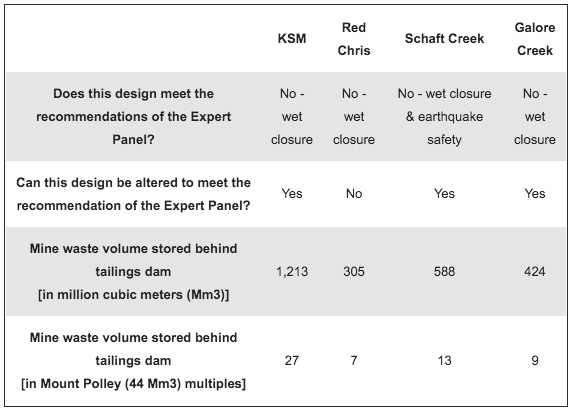Juneau, AK; Ottawa, ON; Washington, D.C., March 22 – In the midst of deliberations over the British Columbia Mining Code, an international coalition today released, Post-Mount Polley: Tailings Dam Safety in British Columbia, a new analysis revealing that four major BC mine projects in the Alaska/British Columbia transboundary region fail to implement the recommendations of the Mount Polley expert panel, risking similar mine waste containment disasters. The Mount Polley mine disaster, considered the worst mine disaster in Canadian history, occurred in August 2014, releasing over 25 million cubic meters of mine waste into the Fraser River watershed.
The KSM, Galore Creek, Red Chris, and Schaft Creek mines would require mine waste dams 2 to 6 times higher than the failed Mount Polley dam, and would contain 7 to 27 times the waste volume. The waste from these four mines would be more toxic than the Mount Polley mine. The expert panel that investigated the cause of the Mount Polley disaster determined that “wet” mine waste disposal, where mine waste is stored with water, should not be used after mine closure to prevent a catastrophic failure. These mines all use wet disposal, and a riskier type of tailings dam construction style.
“Albert Einstein famously defined insanity as doing the same thing over and over, expecting different results,” said Chris Zimmer of Rivers Without Borders. He continued, “but it shouldn’t take an Einstein to figure out that mines using Mount Polley’s mine waste disposal methods risk future Mount Polley-scale mine waste disasters.”
If these mines were to fail, the Unuk, Stikine, and Nass watersheds would be polluted by mine waste, jeopardizing the billion dollar fishing industry that Alaskans and Canadians alike rely on for their livelihood.
“The best time to fix a problem is before it occurs,” said mining expert Dave Chambers. ”The mines proposed in the region are far beyond the scope and scale of Mount Polley, and the consequences of another tailings dam failure are likely to be far worse.”
The new analysis comes during a mining code review initiated by the BC government in response to the Mount Polley disaster. Bill Bennett, British Columbia’s Minister of Energy and Mines, publicly declared his government would implement all of the findings of the Mount Polley investigation. To date it has not done so. According to the Mount Polley expert panel, an estimated two tailings dams are expected to fail every ten years if changes aren’t made.
“When he declared in 2014 that one Mount Polley disaster is one too many, the Minister promised to implement the recommendations of the expert panel that investigated the failure. Two years later it’s time for him to make good on his promise and put these recommendations into policy and practice,” said Ugo LaPointe, MiningWatch Canada.
The report is authored by the director of the Center for Science in Public Participation Dr. Dave Chambers, Ph.D., P. Geop. Dr. Chambers is an internationally renowned expert on the impacts of mining. His August 2015 publication co-authored with Lindsay Newland Bowker, Risk-Public Liability-Economics of Tailings Storage Facility Failures, is a trend analysis of all tailings failures since 1910.
Post-Mount Polley: Tailings Dam Safety in British Columbia was written on behalf of Earthworks, Rivers Without Borders, Southeast Alaska Conservation Council, Inland Passage Waterkeepers, MiningWatch Canada, Friends of the Stikine Society, Sierra Club BC, the David Suzuki Foundation, Pacific Wild, Watershed Watch Salmon Society, the Wilderness Committee, Clayoquot Action, Skeena Wild, and the Canadian Parks and Wilderness Society.



